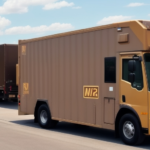Understanding UPS Rates for Shipping
United Parcel Service (UPS) is a global logistics leader, providing package delivery services since 1907. Renowned for its high-quality services, UPS's shipping rates can often seem complex and challenging to decipher. In this article, we delve into UPS shipping rates, explaining how they are determined and exploring the various factors influencing them, supported by recent data and insights.
How UPS Determines Shipping Rates
Understanding UPS shipping rates begins with knowing the key factors UPS considers. Rates are primarily based on package size and weight, destination, and the chosen shipping method. Market demand and competition also play significant roles in pricing strategies.
According to UPS’s 2023 annual report, factors such as fuel costs, labor expenses, and operational efficiencies further influence shipping rates. By analyzing these components, UPS ensures competitive pricing while maintaining service quality.
Additionally, UPS offers a variety of shipping options, including ground, air, and international services, each with distinct rate structures. Specialized services like insurance, tracking, and signature confirmation can also affect the final shipping cost, providing customers with added security and peace of mind.
For a detailed breakdown of how UPS calculates shipping rates, refer to their official Rates and Services page.
The Impact of Shipping Distance on UPS Rates
One of the most significant factors affecting UPS shipping rates is the distance a package must travel. The greater the distance, the higher the shipping costs. UPS offers various options, including air, ground, and international shipping, each catering to different distance ranges and budget requirements.
For instance, shipping a package domestically within the United States via ground service is generally more cost-effective compared to air shipping, which is faster but more expensive. International shipping rates vary widely based on the destination country's distance, import regulations, and transit times.
According to recent industry data, longer shipping distances can account for up to 40% of the total shipping cost, emphasizing the importance of selecting the appropriate shipping method based on distance and urgency.
To optimize shipping costs related to distance, businesses should utilize UPS’s shipping calculator to estimate costs accurately before dispatching packages.
Comparing UPS Ground vs. Air Shipping Rates
UPS offers both ground and air shipping options, each with distinct advantages and cost implications. Ground shipping is typically more affordable and is ideal for non-urgent deliveries, whereas air shipping provides faster delivery times at a higher cost.
- UPS Ground: Cost-effective for domestic shipments, with delivery times ranging from 1 to 5 business days depending on the distance.
- UPS Air: Includes services like UPS Next Day Air, UPS 2nd Day Air, and UPS 3 Day Select, offering expedited delivery for time-sensitive packages.
When choosing between UPS Ground and air shipping, consider the urgency of your shipment and budget constraints. For bulk shipments where time is not a critical factor, ground shipping can result in significant cost savings.
Furthermore, UPS provides detailed comparisons on their Shipping Services page to help businesses make informed decisions based on their specific needs.
Understanding the Different UPS Packaging Options and Their Impact on Rates
UPS offers a variety of packaging options, each affecting shipping rates based on size and weight. Selecting the appropriate packaging can optimize shipping costs and ensure the safety of the items being shipped.
- UPS Boxes: Available in multiple sizes to accommodate different package dimensions.
- UPS Envelopes: Ideal for documents and small items, often resulting in lower shipping costs.
- Specialized Packaging: Options like foam inserts and bubble wrap provide additional protection for fragile items, though they may increase overall package weight and cost.
The choice of packaging material also impacts the dimensional weight calculation, where UPS may charge based on the package's volume rather than its actual weight. Properly measuring and selecting the right packaging can help avoid unexpected costs.
For more information on UPS packaging options, visit their Packaging Services page.
How to Save Money on UPS Shipping Rates
Businesses can implement several strategies to reduce UPS shipping costs:
- Volume Discounts: High-volume shippers often qualify for discounted rates. Engage with a UPS sales representative to explore available discounts.
- Optimize Packaging: Use appropriately sized packaging to minimize dimensional weight charges.
- Leverage UPS Tools: Utilize the UPS shipping calculator and other online tools to streamline the shipping process and reduce errors that can lead to additional fees.
- Subscribe to UPS Programs: Programs like UPS My Choice allow customers to manage deliveries effectively, reducing the chances of missed deliveries and re-shipping costs.
According to UPS, businesses using these strategies can save up to 15% on their annual shipping costs.
For more savings tips, refer to UPS’s Save on Shipping resources.
The Role of Package Dimensions and Weight in UPS Shipping Rates
The dimensions and weight of a package are critical in determining UPS shipping rates. UPS utilizes both the actual weight and the dimensional weight of a package to calculate shipping costs.
Dimensional Weight: This is a pricing technique that considers the volume of a package. It is calculated by multiplying the length, width, and height of the package and dividing by a divisor set by UPS. If the dimensional weight exceeds the actual weight, UPS charges based on the dimensional weight.
For example, a lightweight but bulky package may incur higher shipping costs compared to a smaller, heavier package due to its dimensional weight.
To avoid unexpected charges, ensure that packages are appropriately sized and weights are accurately measured before shipping. Detailed guidelines on dimensional weight calculations can be found on the UPS Packaging Guidelines.
The Effect of Fuel Surcharges on UPS Shipping Rates
Fuel surcharges are additional fees applied by UPS to account for fluctuating fuel prices. These surcharges are dynamic and adjust based on current diesel fuel prices, impacting the overall shipping rate.
The fuel surcharge percentage is recalculated regularly and is reflected in shipping invoices. During periods of rising fuel costs, businesses may notice an increase in their shipping expenses.
It's important to note that the fuel surcharge is not a profit for UPS but a way to manage the variability in fuel prices. For the latest fuel surcharge rates, visit UPS’s Fuel Surcharges page.
How to Properly Calculate UPS Shipping Costs for Your Business
Accurately calculating UPS shipping costs is essential for businesses to maintain profitability. UPS provides several tools and resources to assist in this process:
- UPS Shipping Calculator: Offers estimates based on package weight, dimensions, destination, and chosen service.
- Shipping Estimator Tool: Provides detailed cost breakdowns for various shipping options.
- Shipping Consultants: UPS representatives can offer personalized advice and solutions to optimize shipping strategies.
When calculating costs, consider both the actual and dimensional weight of packages, choose the most cost-effective shipping method, and take advantage of any available discounts or programs. Utilizing these tools can help businesses make informed decisions and manage shipping expenses effectively.
Access the UPS Shipping Services for more details and to use their shipping calculators.
Understanding International UPS Shipping Rates and Customs Fees
Shipping internationally with UPS involves additional considerations, including customs fees and import taxes, which can complicate the shipping process and add unexpected costs.
International shipping rates are influenced by factors such as destination country, package weight and dimensions, and chosen shipping method. Each country has specific customs regulations and fee structures, which can significantly impact the total shipping cost.
UPS offers a brokerage service to handle customs clearance, simplifying the process for businesses and reducing the likelihood of delays or additional charges. However, customs fees and taxes vary by country and are often the responsibility of the recipient.
To better navigate international shipping, businesses should research the customs requirements of the destination country and consider using UPS’s International Services for comprehensive support.
For more detailed information on international shipping rates and customs fees, consult the UPS Customs Information page.
The Pros and Cons of Using Third-Party Shippers with UPS
While UPS provides a wide range of shipping services directly, some businesses opt to use third-party shippers to potentially gain additional discounts and services. However, this approach comes with both advantages and disadvantages.
- Pros:
- Potentially lower shipping rates through negotiated discounts.
- Access to specialized shipping services not directly offered by UPS.
- Streamlined billing processes for businesses with high shipping volumes.
- Cons:
- Increased complexity in the shipping process.
- Potential for discrepancies and errors between third-party shippers and UPS services.
- Less direct control over shipping operations and customer service interactions.
Before deciding to use a third-party shipper, businesses should evaluate their specific needs, shipping volumes, and the potential cost savings versus the added complexity. Consulting with a shipping expert or UPS representative can provide clarity on the best approach for your business.
Tips for Negotiating Better UPS Shipping Rates for Your Business
Businesses that ship frequently have the opportunity to negotiate better shipping rates with UPS. Here are some strategies to achieve more favorable rates:
- Demonstrate Shipping Volume: High shipping volumes provide leverage in negotiations for discounted rates.
- Consolidate Shipments: Grouping shipments can reduce costs and make your shipping needs more attractive to UPS.
- Leverage Data: Presenting shipping data and trends can help in negotiating terms that reflect your business's shipping patterns.
- Explore Service Bundles: Combining multiple UPS services can often lead to bundled discounts.
According to industry experts, proactive negotiations can result in shipping cost reductions of up to 20% for businesses with significant shipping needs.
To begin negotiating, contact your UPS sales representative or visit the UPS Sales and Support page for more information.
Conclusion
Understanding UPS shipping rates is essential for businesses that rely on Shipping services. By comprehending the various factors that influence these rates—such as package size and weight, distance, shipping methods, and additional services—businesses can make informed decisions to optimize their shipping strategies. Utilizing UPS’s tools and resources, staying informed about market trends, and proactively negotiating rates can lead to significant cost savings and enhanced shipping efficiency.
For further assistance and detailed information on UPS shipping rates, visit the UPS Shipping Services page.






















